

IN MEMORy by Pierre Vandervelden
The visit of Commonwealth graves in Communals Cemeteries & Churchyards in Belgium & France
PERTH Cemetery (CHINA WALL) (Zillebeke) (West Vlaanderen Belgium)
Page 1 The Pictures
Page 2 List of Casualties
 |
 |
 |
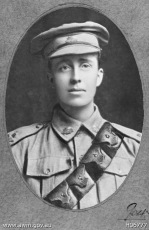 |
| Gnr George Walter Magnus 23/10/1917 For his Great Nephew Clive Lynch (Australia) |
|
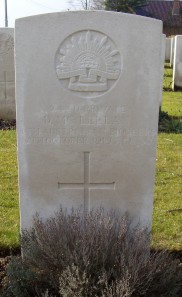 |
 |
| Pte Downie McLellan 12/10/1917 aged
37 Downie was from Bundaberg, Queensland and was killed by artillery fire whilst working on rebuilding the Zonnebeke-Frezenburg road when the infantry of the 3rd and 4th Divisions attacked nearby Passchendaele Ridge. For Jim Donald (Queensland, Aus.) |
|
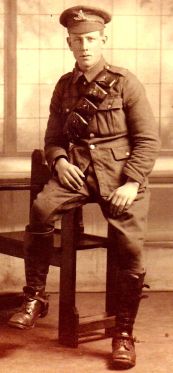 |
 |
 |
| Dvr John George Chapman 26/07/1917
aged 20 for his great great nephew Andrew Robertson |
||
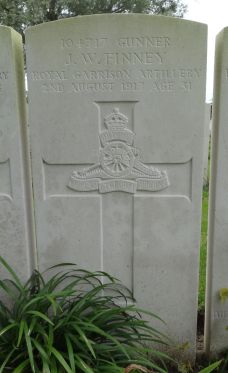 |
 |
| Gnr John William Finney 28/06/1886
- 02/08/1917 John William Mew Finney was born in Westminster. His father (also John William) was a police constable in the Metropolitan Police. His mother Emily Louisa's maiden name was Mew. At the time of his marriage with Amy, on 30/10/1915 he was a wholesale newsagent's clerk. He served with the 230th Siege Battery of the Royal Garrison Artillery in the area around Ieper (Ypres). He returned home to Britain for Christmas 1916 and saw his one week old baby daughter(and only child). She was named using his initials-Joan Winifred Marjorie Finney. John returned to the front and was killed, his muddy, shrapnel holed wallet and wedding ring were returned to his widow. Amy visited his grave few years after the war ended. She raised their daughter and never remarried. When she died in 1977 permission was granted for her ashes to be scattered on John's grave. Their daughter, Joan, qualified as a nurse and midwife and then joined the RAF during WW2. Following D-Day she nursed, under canvas, on what is now Brussels airport (Zaventem) but was unable to visit her father's grave due to the risk of snipers. John has 2 grandchildren and 4 great grandchildren. Two great grandchildren live in Britain while one lives in Germany and another Luxembourg. A fitting tribute that they live in the heart of a free Europe that he helped to liberate. for his and Amy's granddaughter Moira Crowther and family John is also commemorated here. |
|
 |
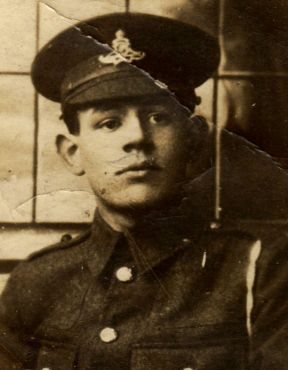 |
| Sjt James Gillies 24/07/1917 He was moved here with 16 others from Manor farm cemetery. for his nephew Dave Inglis (Scotland) |
|
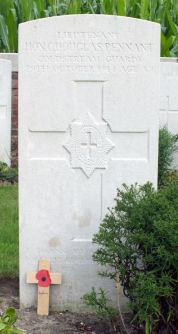 |
 |
| Lt The Hon. Charles Douglas-Pennant
29/10/1914 aged 37 for Tony Pringle and the people of Newmarket |
|
 |
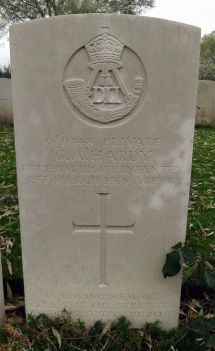 |
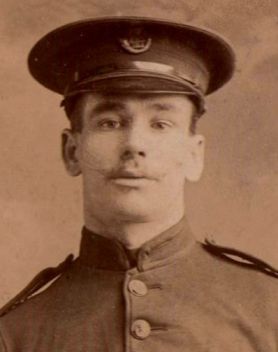 |
| Pte George Allanson Hardy 01/03/1916
aged 32 for Jean Louis Barette |
||
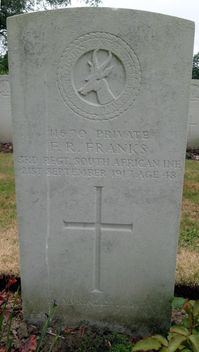 |
 |
| Pte Frank Richard Franks 21/09/1917
aged 48 He died between Vampir Farm and Potsdam Redoubt during the Battle of Menin Road Ridge. He was reburied on 11/11/1919 having been moved from where he was found 10 days after his death & buried by an Australian Reg. moving through the area. During training he was made a temporary Sergeant while in South Africa , when he was sent to England , he reverted to his earlier rank of private. for Perry Davies |
|
| Baptised as “ Richard
Frank Franks “ in 1869, we have no idea when & why he chose to
change the order of his Christian names. The 1881 census records him in Rowde (age 11) as Richard Frank Franks – scholar . The 1891 census (age 21) as Frank Richard Franks - (apprenticed to a chemist ) in Portsmouth. The Franks were of farming stock, originally from Somerset where the earliest record of them dates from the 16th century , the family moved to Wiltshire during the 1850’s, their Rowde farm in Wiltshire being 50% larger than their farm in Lullington , Somerset had been. Indeed members of the family still farm in Wiltshire. As the second son (Frank had 3 brothers & 3 sisters) he was not likely to be expected to become a farmer & by Victorian standards, was well educated, after a grammar school & college education – he qualified as a chemist. A keen athlete & no doubt a superb horseman (more later), he left England for a new life in Southern Africa in 1897, where he took up employment in Southern Rhodesia or Zimbabwe as we now know it. With the Second Anglo Boer War looming – the British authorities sent Lt. Col. Herbert Plumer to establish a militia to protect Southern Rhodesia from possible Boer incursions. He established 2 units – the Rhodesian Regiment & the unit Frank joined – the Rhodesian Volunteers. After the ending of the Siege of Kimberley, the Volunteers were disbanded – Frank, not having had enough war, enlisted in the Imperial Light Horse, the best Colonial troops in the war – with a very high standard of horsemanship required just to make the grade – only 5% of the applicants passed the riding test. After the war Frank was rewarded with the Queen’s South African Medal & the King’s South African medal – both of which were mailed to his widowed mother in England. He met & later married OvidiaImsland (she was always known as Ida) a Norwegian immigrant , they married in 1906. In 1905 he had registered as a chemist in the Transvaal & had made his home in the East Rand – three of his four children being born there, the firstin Brakpan & then two more in Boksburg. The family then moved to Natal & a fourth child was born in Newcastle. He was accepted as a Freemason in Newcastle (his number being – 3091) in July 1914 . He rose to the rank of Junior Deacon. His subs. were fully paid up until 1917. So to the Great War. Frank enlisted on 10thFebruary, 1917 in Benoni, though his address at the time was Newcastle -& so determined is he to join, that he lies about his age, claiming to be 40, rather than his true age of 48. Originally he applied to join the South African Heavy Artillery, but failed the height requirement by an inch, as his medical records show his height as 5ft 7( 1)/( 2). Shipped off to Potchefstroom he undergoes basic training in the South African Infantry. 3 days after enlistment he’s appointed as Acting Corporal & barely a month later he’s promoted to Acting Sergeant. Basic training completed he boards the Durham Castle en route to England on 23rdMarch , 1917. On arrival in England he loses his temporary rank & the serious training begins, he is however granted two weeks furlough at the end of April – I hope he got to see his English family during the period. A three day pass is his last free time in the U.K. as he arrives in Rouen in France on the 29thJune. He joined his unit in the field ( part of a draft of just 11 men ) in Bernaville, near Arras on the 15th July , & is posted to “ C “ Company, 3rd Regiment ( the Transvaal & Rhodesian – generally known as the Transvaal Regiment ). “ C “ Company had as their nucleus men from the Rand Light Infantry. Within a few days , the Brigade is on it’s way toward Ypres & it’s participation in the Battle of Menin Road Ridge, part of the Passchendaele campaign. After several stops en route the final 18km is a march from Poperinge to their position facing their objective – the Bremen Redoubt line. The first objective for “ C “ Company would be Vampire Farm, a heavily fortified farm building. Inside the ruined house was built a blockhouse housing 5 machine guns & the cellar was capable of housing 90 defenders who are sheltered there during British Artillery attacks. The idea being that as soon as the barrage lifts the Germans can move into position, usually in shell holes, with additional machine guns – part of the German strategy of “ defence in depth “, the 5 machine guns in the blockhouse are always manned, regardless of artillery . The Brigade is approx.. 250 metres from their target – shielded from the Germans by a cluster of 3 pillboxes captured by an Irish ( the 48th ) Brigade in a previous failed attack on the position on 16th August, a situation which resulted in 65% casualties before the attack was launched – as their war diary states - “ This was the end of the 9th Dublin Fusiliers “. The South Africans, well aware that as soon as their attack was to begin, the German Artillery would shell their position, moved away from their start line, some 30 to 40 metres into no man’s land & closer to their objective – thereby largely nullifying the German barrage. At 5.40am the attack commenced, the S.Africans, after a wet night out in the mud of no man’s land struggled through almost impossible terrain fighting their way to Vampire farm. They troops were heavily laden usually around 30 – 35kg , I quote : Clothing : on the man + steel helmet. Arms : as issued .303 SMLE Lee Enfield rifle + bayonet. Spades to be taken. Mess tins to be taken. Either back pack or haversack. 1 day’s rations. Iron rations. Tommy’s cooker. Groundsheet. 220 rounds of ammunition. 1 grenade. 3 sandbags. 1 flare. Box Respirator (Gas mask). Covering the 250 meters in an hour & 20 minutes & taking Vampire Farm – 1 officer & 10 other ranks finally completing the job. The South African Brigade was part of the 9th(Scottish) Division & their Scottish allies (the 27th Brigade) were tasked with a first objective of capturing Potsdam Redoubt (7 machine guns). Heavy machine gun fire prevented the Scots from doing so, but the survivors of the attack on Vampire, outflanked the position & their intervention resulted in the capture of Potsdam. Overall the 9th Division captured all of their objectives as tasked. Frank, however was dead, his body lay near Potsdam Redoubt & in the roll call on the 22nd September, he was posted as “ missing “. Of the Regiment’s overall strength of 20 officers & 656 other ranks (total muster of 676 men) – 10 officers & 362 other ranks are listed as casualties – no less than 55% ! Frank is among the 74 men listed as missing. On 3rdOctober, Frank is found by an Anzac unit & buried – here he would remain until the 11th November 1919 when he was reburied at Perth (China Wall) Cemetery . Ida received a £5 gratuity & a pension for herself – 13s 9d per week, & the children (but only until age 16) got a total of 15s per week . Worst of all – Ida had to pay 4s 3d to have “Lead Kindly Light“ carved on Frank’s headstone in Perth Cemetery. The Freemasons now step in, paying for the education of Frank’s 3 sons all of whom go to University. So now the question – What possessed Frank to feel he owed his country a debt of service – after all he was 48 years old – & he had to lie to enlist ? He left a young widow & 4 children, the oldest 11 & the youngest just 4. Ida was left without any family to support her in South Africa, other than her children , although she had arrived in South Africa from Norway together with her brother, Orm , a goldsmith, he had moved on to the USA in January , 1914. Ida died in 1954 & had never remarried. Copmiled by Perry Davies for Frank's family |
|
1 422 casualties
IF You have a casualty picture, please send me a copy, I'll be glad to show it on this page.
IF You want a king size copy of this picture (300/900 ko - 2592/1944 pixels) please e-mail me.
Casualties informations come usualy from Commonwealth War Graves Commission, see links for more informations
Inmemories.com © Pierre Vandervelden - Belgium